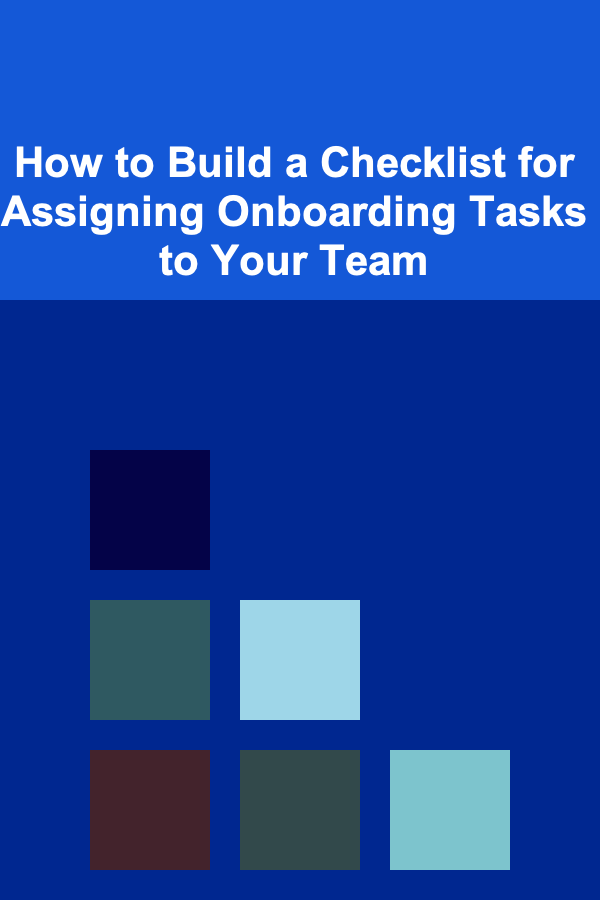
How to Build a Checklist for Assigning Onboarding Tasks to Your Team
ebook include PDF & Audio bundle (Micro Guide)
$12.99$6.99
Limited Time Offer! Order within the next:

Onboarding is a critical process for any organization. It not only helps new employees integrate into the company culture but also ensures that they are well-equipped with the necessary tools, knowledge, and resources to succeed in their roles. One of the most effective ways to manage this process is by creating a comprehensive checklist for assigning onboarding tasks to your team. A well-organized checklist ensures that nothing is overlooked and that the process is efficient and smooth.
In this guide, we'll walk you through how to build a checklist for assigning onboarding tasks to your team, providing actionable steps that will streamline the process and ensure your new hires feel welcomed and prepared from day one.
Understand the Purpose and Scope of Onboarding
Before diving into the specifics of the checklist, it's essential to define what you want the onboarding process to achieve. Onboarding is not just about administrative tasks; it's about ensuring the new employee has everything they need to start their role successfully. The scope of your checklist should align with these core objectives:
- Cultural Integration: Introducing the new hire to your company's culture, values, and mission.
- Role Familiarization: Helping them understand their responsibilities, team structure, and performance expectations.
- Tools & Resources Setup: Ensuring they have access to the necessary tools, software, and documents.
- Compliance & HR Requirements: Completing necessary paperwork and ensuring compliance with legal and company policies.
Actionable Tip:
Spend time discussing the goals of your onboarding process with relevant stakeholders, such as HR, team leaders, and managers, to ensure everyone's expectations are aligned.
Map Out the Onboarding Phases
Onboarding is a multi-step process, and each step will require specific tasks. To create an effective checklist, break the process down into clear phases. Here's how you can organize them:
2.1. Pre-Onboarding (Before Day 1)
Pre-onboarding starts once the candidate has accepted the offer but before their first day at work. This phase involves preparing everything needed for a smooth first day.
Tasks in this phase include:
- Prepare Workstation: Set up the new hire's desk, computer, phone, and other necessary equipment.
- Email and Account Creation: Create email accounts, access to internal communication platforms (Slack, Microsoft Teams, etc.), and other software/tools they'll need.
- Send Welcome Kit: This could include company swag, an employee handbook, and a welcome letter from their manager or the CEO.
- Schedule Meetings: Set up initial introductory meetings with key team members and managers for their first week.
2.2. Day 1 (Orientation and Introduction)
The first day sets the tone for the new hire's experience at your company. Ensure they feel welcomed and oriented.
Tasks for Day 1:
- Welcome Session: Greet the new hire, give a tour of the office (or virtual introduction if remote), and introduce them to their team.
- Company Overview: Review the company's mission, vision, values, and culture.
- IT Setup: Ensure all systems, accounts, and software tools are functioning and accessible.
- HR Paperwork: Complete any remaining administrative tasks, such as benefits enrollment, tax forms, or confidentiality agreements.
2.3. Week 1 (Training and Role Immersion)
In this phase, the new employee begins to dive into their role, learning the processes, systems, and tools they will use.
Tasks for Week 1:
- Role Overview: Discuss their specific job responsibilities, expectations, and key performance indicators (KPIs).
- Team Introductions: Schedule one-on-one meetings with colleagues and cross-functional teams.
- Training Sessions: Start any role-specific training, such as software tools, internal processes, or product knowledge.
- Shadowing: Allow the new hire to observe experienced team members to understand workflows and processes.
2.4. Ongoing (Beyond the First Week)
Onboarding doesn't end after the first week. This phase is about continued development and integration.
Tasks for Ongoing:
- Continuous Training: Provide ongoing learning opportunities, including mentorship, webinars, or additional role-specific training.
- Feedback Sessions: Regular check-ins with the new hire to assess progress, answer questions, and provide feedback.
- Cultural Integration: Encourage participation in team-building activities, company events, and other initiatives to build relationships.
- Performance Reviews: Schedule a 30-day or 90-day performance review to assess the new hire's growth and make necessary adjustments to their training.
Actionable Tip:
Ensure that each phase has clearly defined tasks and expectations. Avoid overwhelming new hires with too much information in the first few days. Gradually build their knowledge and responsibilities.
Create Task Categories for Better Organization
Once you've broken down the onboarding process into phases, it's time to organize the tasks. A checklist should be comprehensive but not cluttered. Categorize the tasks to make it easier for managers and HR to assign and track progress.
Categories to Include:
- Administrative: Tasks related to paperwork, account creation, benefits enrollment, etc.
- Technology Setup: Setting up devices, software, email accounts, and communication tools.
- Role-Specific: Training on job duties, tools, and processes related to the new hire's position.
- Team Integration: Introducing the new hire to colleagues, setting up team meetings, and fostering a sense of belonging.
- Cultural Orientation: Educating new hires about company values, team dynamics, and social events.
Actionable Tip:
Use color coding or tags to indicate priority and dependencies between tasks. For example, tasks that need to be completed before the first day (pre-onboarding) can be marked in one color, while those that should be completed in the first week can be in another.
Delegate Responsibilities for Each Task
Assigning tasks is crucial for ensuring everything gets done on time. Identify who is responsible for each task on the checklist---this could include HR, IT, managers, or even specific team members. Having clear ownership prevents confusion and ensures accountability.
- HR Responsibilities: HR will typically be in charge of administrative tasks, such as benefits enrollment and paperwork.
- IT Team: The IT department will handle all technology setup, such as creating email accounts, installing software, and ensuring access to internal tools.
- Manager Responsibilities: The manager should oversee the new hire's role-specific training, team introductions, and performance feedback.
Actionable Tip:
Assign a checklist coordinator (perhaps an HR representative or team lead) to oversee the entire onboarding process. This person will ensure that tasks are completed on time and that any issues are addressed promptly.
Leverage Technology to Streamline the Process
Using digital tools and software can significantly improve the efficiency of your onboarding process. Many organizations leverage human resources management systems (HRMS), project management tools, and onboarding platforms to automate and streamline task assignments.
Recommended Tools:
- HRMS Platforms: Platforms like BambooHR, Gusto, or Workday can automate many of the administrative aspects of onboarding, such as paperwork and benefits enrollment.
- Project Management Tools : Tools like Asana, Trello, or Monday.com can be used to create and manage onboarding task checklists, assign tasks to team members, and track progress.
- Onboarding Platforms: Tools such as Sapling, Rippling, or Greenhouse are designed specifically to manage onboarding workflows, making it easier to keep track of tasks and deadlines.
Actionable Tip:
Consider integrating onboarding checklists into your existing project management or HR tools. This will make it easier to track progress and keep everything centralized.
Measure and Iterate Your Onboarding Process
Lastly, it's important to continuously evaluate the effectiveness of your onboarding process. Regularly gather feedback from new hires, managers, and other stakeholders to understand what's working well and what needs improvement.
- Surveys: Send out surveys after the onboarding process to assess the new hire's experience.
- Exit Interviews: If employees leave after a short tenure, ask about their onboarding experience to understand any gaps.
- Regular Reviews: Hold periodic reviews with HR and team leaders to discuss the onboarding process and make necessary adjustments.
Actionable Tip:
Use feedback to improve the checklist over time. Make sure that the onboarding process is evolving with the company's growth and changes in the job market.
Conclusion
Building a checklist for assigning onboarding tasks is a vital step in ensuring new hires feel welcomed, supported, and well-prepared for their roles. By breaking down the process into manageable phases, categorizing tasks, and leveraging technology, you can streamline the onboarding process and foster a positive experience for your new team members.
Remember, effective onboarding doesn't just impact employee productivity---it also influences employee retention, job satisfaction, and long-term success. By prioritizing organization and consistency in your onboarding process, you're setting the foundation for a thriving workforce.
Reading More From Our Other Websites
- [Organization Tip 101] How to Create a Functional Entryway with Storage Solutions
- [Home Maintenance 101] How to Maintain Your Home's Siding
- [Home Family Activity 101] How to Turn Family "Restaurant" Night at Home into a Five-Star Experience for All Ages
- [Organization Tip 101] How to Designate Spaces for Mail and Important Documents
- [Home Staging 101] How to Make Your Home Look Bigger with Staging Techniques
- [Home Lighting 101] How to Use Uplighting to Highlight Architectural Features
- [Whitewater Rafting Tip 101] 10 Must-Try White-Water Rafting Destinations for Your Bucket List
- [Home Holiday Decoration 101] How to Make Your Bedroom Feel Festive for the Holidays
- [Home Maintenance 101] How to Integrate Chimney Cleaning into Your Annual Seasonal Home Maintenance Guide for Safety and Efficiency
- [Personal Care Tips 101] How to Use Hair Serum to Reduce Hair Breakage and Split Ends

How to Choose the Right Lighting for a Cozy Bedroom
Read More
How to Maximize Your Tax Refund Each Year
Read More
How To Understand the Social Impact of Coffee Production
Read More
Mastering Positive Self-Reinforcement: A Deep Dive
Read More
How to Tackle Yard Work with Limited Time: A Prioritized List
Read More
How to Predict Drug-Drug Interactions Using Pharmacological Principles
Read MoreOther Products

How to Choose the Right Lighting for a Cozy Bedroom
Read More
How to Maximize Your Tax Refund Each Year
Read More
How To Understand the Social Impact of Coffee Production
Read More
Mastering Positive Self-Reinforcement: A Deep Dive
Read More
How to Tackle Yard Work with Limited Time: A Prioritized List
Read More